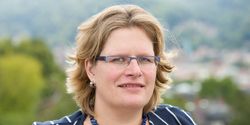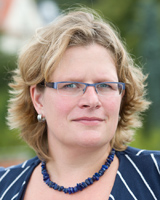The Mistress of Particle Chaos
In the LHCb experiment at CERN, Stephanie Hansmann- Menzemer searches for phenomena that cannot be explained with common physical models.
After a trillionth second and seven millimetres, it’s all over. That’s the lifetime of the particles that Stephanie Hansmann-Menzemer observes at the Large Hadron Collider (LHC), the particle accelerator of the European Organization for Nuclear Research in Geneva – a life span that begins with the collision of two protons. After a trillionth second the particles break down and Hansmann-Menzemer attempts to analyse the ensuing chaos. She traces the paths of the particles and tries to find explanations for what happened.

The Heidelberg particle physicist is especially interested in neutral B mesons, also known as beauty hadrons. These particles are subject to constant change in the time between their production and decay. We can measure what kind of particle they are at the time they break down, and in two out of three cases, we can infer which particle was created in the original collision. But strange things happen in between – during this period so called quark mixing happens: particles turn into their anti-particles and back, and even the basic principle of energy conservation may be briefly overturned. The particle-anti-particle oscillation may briefly give rise to particles that are much heavier than they should be, considering the energy of the B mesons – one of them is the top quark. Its existence can only be proven indirectly via its influence on the oscillation, which Hansmann-Menzemer wants to measure more precisely. She hopes to discover clues to particles that are heavier than the energy of the two colliding protons.
Although beauty hadrons only exist for such a minimal time, they have an impact on observable processes. Their oscillation, i.e. their constant changing during quark mixing – a process that was explained largely through Hansmann-Menzemer’s work – might cause the particles and anti-particles, which should be completely symmetrical, to act slightly differently.
This asymmetry is measured by Hansmann-Menzemer and her team. The scientist wants to know whether any asymmetries occur during the mixing phase that are greater than predicted by the “standard model” of particle physics – if so, then Hansmann-Menzemer would have found what she is looking for: a decisive clue to what has been termed “new physics”. Based on these results, theoreticians might even be able to explain why we live in a world that is composed of matter, while all antimatter has disappeared from the universe.
The term “new physics” describes phenomena that can no longer be explained with the standard model – such phenomena have been systematically explored for 40 years and are characterised with terms like Higgs bosons, dark matter and God particles. Perhaps, so the assumption goes, such phenomena occur only in the presence of extremely high levels of energy – in the same way that Newton’s laws only offer a sound explanation of mechanics at low velocities, while Einstein’s theory of relativity must be applied to velocities that approach the speed of light.
To date, however, no asymmetry has been found that is significant enough to discard the existing standard model. If Hansmann-Menzemer and her colleagues in Geneva find indicators for new physics, they may reinforce the major unifying theories that deal with such complex issues as strings and supersymmetric particles. Or Hansmann-Menzemer’s findings will force theoreticians to return to square one and develop new models.
“It would be really disappointing if we didn’t find any new particles or phenomena at all”, she says, “because that would cause people to question our entire discipline.”
However, researchers at CERN think that is unlikely. Even at their last joint winter conference, most teams had adapted their routines at the accelerators and detectors so that all findings related to particle physics up to that time could be reproduced. Since then, the researchers have been exploring uncharted territory. “By now, we have captured ten times more data for B mesons than ever before, and that’s just the beginning”, says Hansmann-Menzemer. The energy with which protons collide in the LHC reaches approximately 14 teraelectronvolts, more than seven times the amount in the Tevatron in Illinois, USA, the most powerful accelerator in the world prior to the LHC.
Hansmann-Menzemer leads a junior research group at the Heidelberg Institute for Physics; the group is supported with more than one million EUR by the European Research Council (ERC). The aim of the ERC is to support outstanding young scientists in high-risk research projects. When the 36-year-old scientist from Karlsruhe had to decide on a German university after terms in Spain and at the Massachusetts Institute of Technology in the USA, Heidelberg stood out mainly by its large number of highly trained students. “Nothing is more important for my research than good diploma and PhD students”, she says. “They’re the only ones that spend 100% of their time on the actual research project. Older researchers are always involved in lectures, administrative tasks and earlier projects.”
To her mind, it is an advantage that German PhD students are often a little older than their international colleagues. “In discussions, they can easily hold their own against international postdocs.” That is another reason why Hansmann-Menzemer declined the offer of a permanent position in England.
As German LHCb Outreach Coordinator, Hansmann-Menzemer also develops exhibitions and translates her work into presentations for the media and the wider public. She is not comfortable with the fact that research at CERN is often portrayed as being able to supply the ultimate explanation of the formation of the universe, the meaning of life, or even God. “Our research is exciting enough as it is. We don’t need metaphysics.”
Short Biography
Prof. Dr. Stephanie Hansmann-Menzemer
 Stephanie Hansmann-Menzemer studied mathematics and physics in Karlsruhe and originally planned on becoming a teacher. During a stay at Grenoble in France, she took an interest in research. She earned her PhD in experimental particle physics in Karlsruhe and then worked as a postdoctoral researcher first at the Massachusetts Institute of Technology in the USA and then at Universidad de Cantabria in Spain. In Heidelberg, she became head of an Emmy Noether junior research group in 2006, and in 2009 was appointed to a start-up professorship supported by Excellence funding. Hansmann-Menzemer received the Tollestrup Award for outstanding postdoctoral research (2006) and the Young Researcher Award of the European Physical Society (2007) for her measurements of the mixing frequency in the B hadron system.
Stephanie Hansmann-Menzemer studied mathematics and physics in Karlsruhe and originally planned on becoming a teacher. During a stay at Grenoble in France, she took an interest in research. She earned her PhD in experimental particle physics in Karlsruhe and then worked as a postdoctoral researcher first at the Massachusetts Institute of Technology in the USA and then at Universidad de Cantabria in Spain. In Heidelberg, she became head of an Emmy Noether junior research group in 2006, and in 2009 was appointed to a start-up professorship supported by Excellence funding. Hansmann-Menzemer received the Tollestrup Award for outstanding postdoctoral research (2006) and the Young Researcher Award of the European Physical Society (2007) for her measurements of the mixing frequency in the B hadron system.

